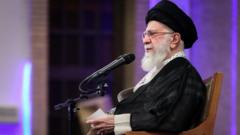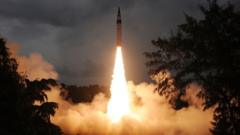The organization warns of significant dangers posed by misinformation, nuclear arms, and climate change.
Doomsday Clock Ticks Closer to Midnight: A Warning of Impending Catastrophe

Doomsday Clock Ticks Closer to Midnight: A Warning of Impending Catastrophe
The Bulletin of the Atomic Scientists advances the Doomsday Clock, citing escalating global threats.
The world teeters on the brink of catastrophe, as the Bulletin of the Atomic Scientists has officially moved the Doomsday Clock one second closer to midnight, now standing at 89 seconds. This alarming adjustment serves as a wake-up call regarding the profound threats posed by nuclear warfare, climate change, and the potential misuse of artificial intelligence and biological sciences. The decision was announced during a press conference in Washington, where prominent figures, including ex-Colombian President Juan Manuel Santos and Princeton professor Robert Socolow, addressed the pressing concerns underlying this shift.
The Bulletin emphasized the urgency of this decision, stating, “With the world already perilously close to the brink, even a single second indicates extreme danger and highlights the critical need for immediate action.” Their collective expertise encompasses fields like nuclear technology and climate science, underscoring the multifaceted nature of today’s global threats.
Historically, the Doomsday Clock, created in 1947 in the wake of escalating Cold War tensions, gauges humanity's proximity to annihilation based on global threats. The clocks hands have fluctuated widely—from a hopeful 17 minutes to midnight in 1991, post the Strategic Arms Reduction Treaty, to today's less-than-optimistic placement, influenced largely by recent geopolitical developments, including the war in Ukraine, during which the clock was reset from 100 seconds to 90 seconds in January 2023.
The latest change reaffirms the Bulletin's commitment to raising awareness about the expansive dangers that threaten human existence, a mission deeply rooted in a desire to foster constructive dialogue and action on critical global issues.
The Bulletin emphasized the urgency of this decision, stating, “With the world already perilously close to the brink, even a single second indicates extreme danger and highlights the critical need for immediate action.” Their collective expertise encompasses fields like nuclear technology and climate science, underscoring the multifaceted nature of today’s global threats.
Historically, the Doomsday Clock, created in 1947 in the wake of escalating Cold War tensions, gauges humanity's proximity to annihilation based on global threats. The clocks hands have fluctuated widely—from a hopeful 17 minutes to midnight in 1991, post the Strategic Arms Reduction Treaty, to today's less-than-optimistic placement, influenced largely by recent geopolitical developments, including the war in Ukraine, during which the clock was reset from 100 seconds to 90 seconds in January 2023.
The latest change reaffirms the Bulletin's commitment to raising awareness about the expansive dangers that threaten human existence, a mission deeply rooted in a desire to foster constructive dialogue and action on critical global issues.




















